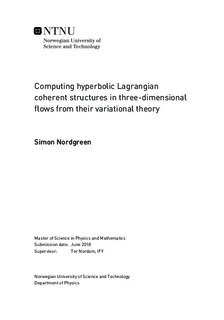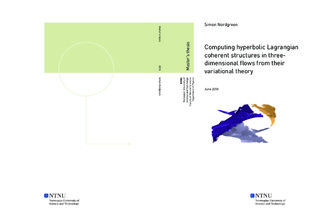| dc.description.abstract | Lagrangian coherent structures (LCSs) are dynamic surfaces that shape the flow patterns in complex transport systems. Accurate identification of LCSs has applications in particle transport, including dissemination of oil in water following major oil spills and airborne ash after volcanic eruptions. While methods exist for identifying LCSs by use of their variational theory in two-dimensional systems, limited effort has previously been given to extending these methods to three dimensions. Where some systems are reasonably approximated as two-dimensional, LCSs in other firmly three-dimensional systems have commonly been computed by combining two-dimensional cross sections.
Aiming to develop a dedicated method for computing three-dimensional hyperbolic LCSs, this study combines existing LCS theory with recognized methods for computing three-dimensional manifolds. This approach is outlined with respect to its theoretical foundation, as well as resource management and accuracy concerns. Moreover, reference test cases are used to confirm method accuracy in terms of reproducing simple manifolds and LCSs. Inquiring as to the robustness of these LCSs, we also apply the method to a well-known three-dimensional steady velocity field, using a time-perturbed variation of the same field for comparison. The high degree of similarity between the resulting LCSs indicate a high degree of LCS robustness. This robustness is considered desirable, as it suggests low sensitivity to the velocity field inaccuracies associated with commonly used gridded data models for flow fields.
While these results seem promising, it remains to be seen whether the three-dimensional approach is sufficiently advantageous in terms of accuracy and descriptive power to justify the corresponding disadvantages with respect to complexity and resource requirements. | |

